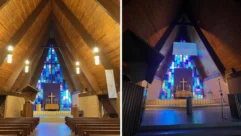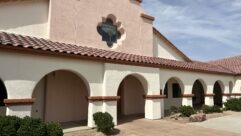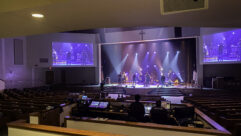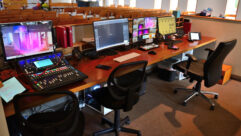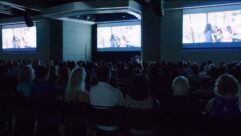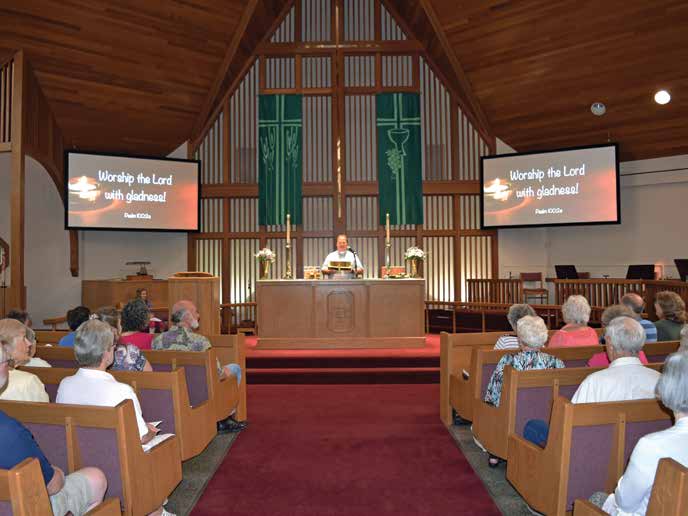

SVC: About the Calvary Lutheran Church nearby in Grants Pass, they wanted to get more into big screen video. And that church has an older congregation?
Steve Diamond: They are an older congregation, there’s no question about it, but they are striving to draw younger families and youth into the church.
And when those churches call Diamond Support Services, what are they looking for? What do you mainly do for them?
Our mission is to serve the body of Christ. I have been in the audio field since 1973, so I’ve got a few years under my belt. I had a company here in Oregon that did national and international work for many years and last fall I sold my percentage in the company. The new company that purchased the company that we had had a different vision. They only wanted to serve mega churches and work with budgets that were fairly large. My heart has always been to serve the smaller- and medium-sized churches and so we parted company the beginning of December of last year. In January I started Diamond Support Services to continue to serve the smaller and mid-sized churches. We do large churches, too, don’t get me wrong. But my focus is definitely small- and mid-sized, because they tend to be the ones that really need some guidance and some help. My main focus is serving the church. So I tend to give them good deals, but more than that I give them solid advice and really take into account their budgets. I try not to exceed their budgets, but I am a realist with them. And I also tend to move them towards wise stewardship decisions where they’re spending the money once and spending it wisely. Not necessarily buying cheap. It may be expensive, but it’s something that will last them a decade or two. And I feel that is a much better value than selling them something they fight with and then five years later they replace it because they’re too tired of fighting with it.
You mentioned the younger crowd. Were they just trying to blend the congregation better and get into a little more sophisticated video system?
They’re trying to blend the church better. They have a good contingent of seniors and they’re trying to draw in those families and the youth. They’re trying to get a little younger in their technology. Previously, they used a small projector that was just sitting on a cart and they would pull down a screen and put the words and sermon notes and that kind of thing on the screen, and the seniors couldn’t see it very well. The room has three glass walls. The rear wall and the two side walls are predominantly glass and there’s a tremendous amount of horizontal light that comes into the room through all that glass. So that was one of the challenges about getting them a good solution where the seniors could read the words clearly and see clearly and the youth would come in and go, “Wow, they have cool video.”
So some problem-solving to do?
Yeah. We talked about curtains being pulled over the glass and all that kind of stuff. But most of the people in the church were very taken by the architectural aspects of the building and didn’t want to block out all the natural light that was coming into the room. We did mock-up of screens and showed them where the screens would hang, that kind of thing, but they weren’t really taken by the aesthetic at that point in time.
So you installed a couple of Eiki 810U projectors I think. What was the attraction of those particular ones?
Yes, we did put in Eiki 810U’s. The attraction was two-fold. First of all, it’s an 8,000- lumen projector and 8,000 lumens is pretty good power at a reasonable price as far as the ability to cut through the existing light and space. And the second aspect is that it was a dual laser, and that in itself has a couple of benefits. The dual laser has a blue laser and a red laser, so color rendition is extremely true and extremely natural-looking. Plus it has an extremely high contrast ratio in those projectors. You’re looking at about 100,000 to 1 contrast ratio. So contrast was really important, especially for the seniors in that congregation to be able to see writing clearly.
I looked through the specs on these and there’s a liquid cooling feature for the optics. How does that work?
[Laughs] That’s a good question. I would think that is a closely-guarded secret. I don’t know the specific engineering regarding, but I will say this. The cooling aspect negates the need for filters in the projector. It is a sealed light unit. It has a 20,000 hour guarantee on it. It doesn’t require filters being changed or even being cleaned, so the maintenance is extremely low. And for an older congregation, having less maintenance is a big deal.
And from where do you control these projectors? What do you use, serial or LAN, how do you do that?
Everything is set in their little booth at the back corner of the room. Not my favorite place to put a booth, but that’s where it is. It is definitely a wired LAN. They use an iMac through an ATEN matrix and the wired LAN gives us a very good IP control and allows us to remote in, if necessary, to help them. That’s a big deal. We also set it up that the projector would notify us if something goes wrong. So we know sometimes before they do if there’s a problem.
And how do you get the video signal up to the projectors? Is it HDBaseT or how do you handle the video signal?
We are doing HDBaseT and we use an ATEN, four-in/four-out matrix so that they can hook up their computer and they can hook up a DVD player and whatever. And that gives us the ability to get the signal right up to the projectors.
Sounds like the easiest way to get all the sources up there and once you do, what’s the actual throw distance from the projectors to the screens?
There are two screens, two projectors. From each projector it’s a 57-foot throw to the screen. So long-throw lenses were specified along with the projectors. The projectors basically don’t come with a lens; you specify the lens.
What was behind the selection of the Crystal Screens display surfaces?
Well, you know, as I told you last time we spoke that three of the walls are window walls, basically. They’re glass – predominantly glass – and we had a tremendous amount of horizontal light that we’re dealing with that has to be overcome to give a good picture. Crystal Screens is one of only just a couple of companies using a new screen material that rejects ambient light and really gives you a clear picture from the projector, but gets rid of all that horizontal light that’s coming into the room. And we went with what is called their Reflect 3.0, that’s a +3 gain, with a 70-degree viewing angle. We went with two of those screens, which covered the room beautifully. But by going with the Reflect 3.0 we were able to really get a great picture without the horizontal light really coming into play.
And rather than mounted on the wall, I believe the screens are suspended. How long did it take you to get those up and oriented the right way?
It was about two guys and two hours. We took the frame – the velvet-covered frame that came with the screens – and we used a tap and die set to make holes through the aluminum frame. And then we were able to use wire rope to suspend those from the ceiling at exactly the right angles.
Those screens had to have a huge effect on the brightness and the clarity of those projectors in that ambient light. I’m sure the church crew was impressed.
Unbelievable. When we turned on those projectors and we put a picture through it, the people who were there from the church were kind of helping and hanging out and watching gasped. It was such a great picture. And I will say this. Crystal Screens basically manufactured these screens for us – custom – because up to that point they hadn’t done large screens. The screens were limited to about a 6×8 and these are a little larger than that, so they had to figure out how to put these pieces together of the screen material so that it would work. We have 134-inch diagonal picture that we were shooting onto that screen, and they successfully made the seam. We tensioned the screen onsite and then mounted it as I’ve described.
And I think you also made some modifications to the sound system including relocating the front of house mixer.
About a year and a half, two years ago I put in an Allen & Heath GLD digital console for them. And the reason that I went with the digital console is that previously they had an analog console, but their congregation didn’t really know how to operate a control board. There was nobody there who was technicallyminded and there was no tech in charge of it. So by going with the digital console, I could do a lot of the setting up of the console for them and then they could use a recall button to recall different scenes that I had set up for them.
What type of wireless mics did you install for the church?
We installed Shure QLX-D digital microphones. They are a very high-quality mic, very good-sounding mic. Very, very, very low opportunity for interference using those digital microphones. And they don’t have a lot of wiring in their church because they were a very traditional church when the building was built, and they had a microphone from the lectern and one microphone over by the side and that’s about it. So I was able to get a CAT-5 cable pulled around and put in a digital stage box so they could take some of the instruments that they’re using now, and give them a place to connect to the control board via that. We have 12 channels of QLX-E wireless there, eight of which are for their side mic singers, and we have DPA headset cardioid microphones for their singers going to belt packs. And then we have several hand-helds, including one that is now being used from the lectern because the wiring was very, very old and not in good shape and it was just easier to go wireless.
And what else did you do on the sound system before that was wrapped up?
Well, we’re in the process of right now planning their speaker change out. The speakers they have were produced by Apogee back in the mid 90s and they were good speakers. I wasn’t crazy about the hang or some of the other aspects of it – but it’s a good speaker. So I said let’s keep these speakers and go step by step and over the course of time we will figure everything out. For example, I found that they had two speakers, one for each half of the room, and the amplifier had only one working channel. So I called another church down there in Grants Pass that I have a relationship with and I said, “Do you have a spare amp I could borrow?” I hooked it up, and all of a sudden they’re going, “Oh, my goodness. That’s why we couldn’t hear.” And all of a sudden the sound was decent. We just recently put in a new PowerSoft four-channel amplifier. PowerSoft is a one-rack space/one-rack unit amplifier that puts out absolutely fantastic sound. In my planning for this future speaker replacement, that amp will actually drive all of the speakers that we’re going to put in the room. As far as the antennas for mic receivers, we put in a couple of antenna combiners for all of their microphones so they don’t have the porcupine back there with all the antennas sticking up. It’s one set of antennas and it feeds through different combining networks to feed all of the microphone receivers.
Yeah, make it work better, too without all those antennas reflecting off of each other. So what’s coming up next for Diamond Support Services? You got any other projects coming down the line?
Well, I head to Singapore this week to meet with a couple of churches. And we’re also working with a church in Hawaii that is in the process of building a new building and we’re doing all the sound, lighting, video and acoustics for that as well. My background is in acoustics – it’s a big part of what I do. I have my certificates, if you will, in acoustics and audio engineering, but the guys that work with me are video specialists, lighting specialists, etc. So we can handle a pretty good-sized facility with the team we have.


